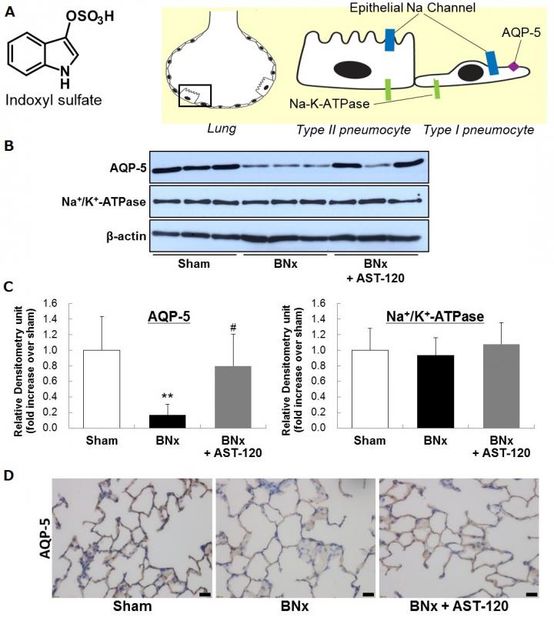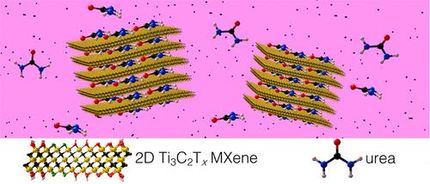High indoxyl sulfate levels caused by acute kidney injury damages lungs
acute kidney injury (AKI) is sudden kidney failure or damage lasting from a few hours to several days. During this time, the kidney's ability to maintain a proper balance of bodily fluids is compromised and causes a buildup of waste products in the blood. There are several causes of AKI including decreased blood flow to the kidneys, direct kidney damage, and blockage of the urinary tract. The mortality rate for AKI is relatively high and is often exasperated by complications with the respiratory system. Unfortunately, the relationship between lung injury and AKI is not completely understood.

Indoxyl sulfate chemical formula (A left) and the epithelial sodium channel of lung alveolar cells (A-right). AQP-5 and Na+/K+-ATPase protein expressions of the lung in BNx rats. Protein expressions of AQP-5 and Na+/K+-ATPase of the lung in sham-operated rats (sham), BNx rats with (BNx + AST-120) or without (BNx) oral administration of AST-120 (2.5 g/kg) at 48hr, were determined by Western blot analysis (B, C) and Immunohistochemical analysis (D) with antibody against rAQP-5. Each column represents the mean +/- S.D. from 3 rats. **p < 0.01 versus sham; # p
Dr. Hideyuki Saito
To find a connection between acute lung injury (ALI) and AKI, researchers from Kumamoto University in Japan developed a bilateral nephrectomy (BNx)-induced AKI rat model. Based on previous research, they focused mainly on indoxyl sulfate (IS), a chemical that contributes to kidney disease that is normally excreted in urine but remains in the circulatory system of those with kidney disease. The experiments included three subject types, sham-operated (sham), BNx, and BNx rats that were given the orally administered intestinal sorbent AST-120 (BNx+AST-120), which decreases uremic toxins like IS.
The researchers had two goals, to see if IS affected aquaporin 5 (AQP-5), a protein with the main function of transporting water across lung cell membranes, and to determine if IS plays a role in the development of ALI during instances of kidney injury or disease. Their results showed that serum IS levels and IS organ accumulation (lungs, liver, heart, intestine) 48 hours after surgery was significantly higher for BNx rats than both the sham and BNx+AST-120 rats. Histological analyses of lung tissues revealed a significant reduction of interstitial tissue thickening in the BNx+AST-120 rats compared to the BNx rats. Furthermore, Western blot and immunohistochemical analyses helped confirm that the BNx+AST-120 rats had AQP-5 levels similar to the sham rat.
"Our work confirms that acute kidney damage results in an accumulation of IS in lung tissue and may cause acute lung injury through renopulmonary crosstalk," said lead researcher Dr. Hideyuki Saito. "In other words, IS accumulation acts to dysregulate the expression of salt and water channels in the lungs leading to thickened tissue and lung damage. Fortunately, we also found that oral treatment with the intestinal sorbent AST-120 had the positive effect of returning interstitial lung tissue to a relatively normal thickness by decreasing production and pulmonary accumulation of IS."
One limitation of this study was the low number of test subjects; the experimental procedure only used three rats for each of the three surgical variables. However, future studies are planned to clarify mechanisms involved in the dysregulation of AQP-5 by IS, which may further support the results of this study.
The findings of this research shine a new light on the role that AKI plays in the development of ALI, i.e., renopulmonary crosstalk, and may provide insight into new therapeutic approaches.
Original publication
Yabuuchi, Nozomi and Sagata, Masataka and Saigo, Chika and Yoneda, Go and Yamamoto, Yuko and Nomura, Yui and Nishi, Kazuhiko and Fujino, Rika and Jono, Hirofumi and Saito, Hideyuki; "Indoxyl Sulfate as a Mediator Involved in Dysregulation of Pulmonary Aquaporin-5 in Acute Lung Injury Caused by Acute Kidney Injury"; International Journal of Molecular Sciences; 2017
Most read news
Original publication
Yabuuchi, Nozomi and Sagata, Masataka and Saigo, Chika and Yoneda, Go and Yamamoto, Yuko and Nomura, Yui and Nishi, Kazuhiko and Fujino, Rika and Jono, Hirofumi and Saito, Hideyuki; "Indoxyl Sulfate as a Mediator Involved in Dysregulation of Pulmonary Aquaporin-5 in Acute Lung Injury Caused by Acute Kidney Injury"; International Journal of Molecular Sciences; 2017
Topics
Organizations
Other news from the department science

Get the life science industry in your inbox
From now on, don't miss a thing: Our newsletter for biotechnology, pharma and life sciences brings you up to date every Tuesday and Thursday. The latest industry news, product highlights and innovations - compact and easy to understand in your inbox. Researched by us so you don't have to.

























































